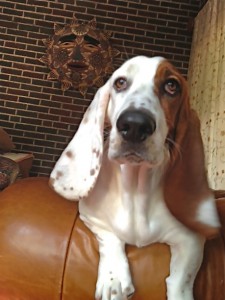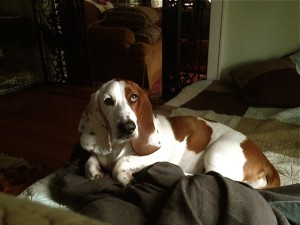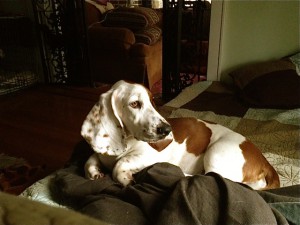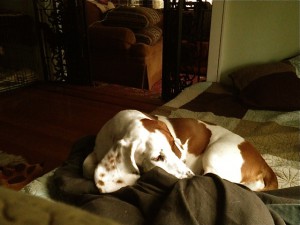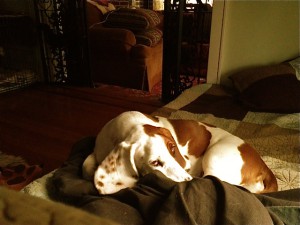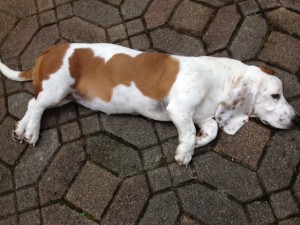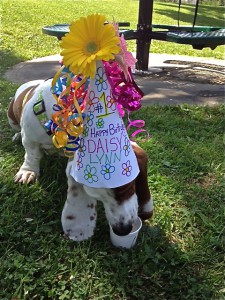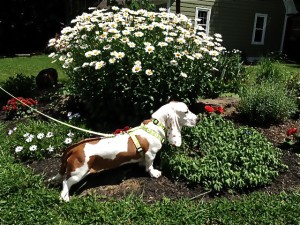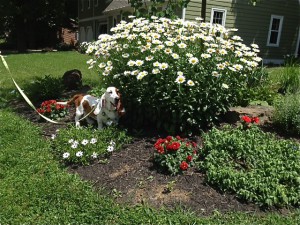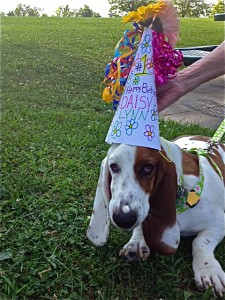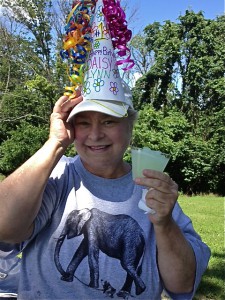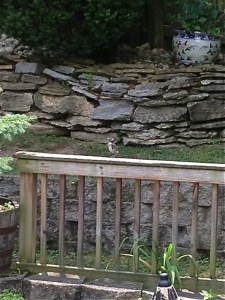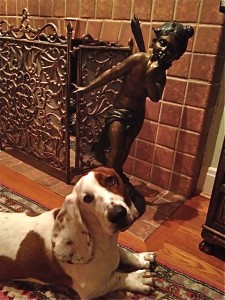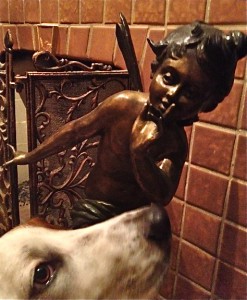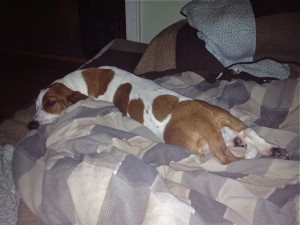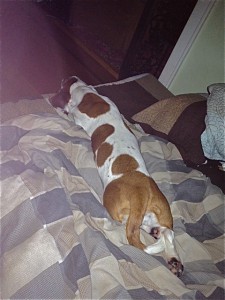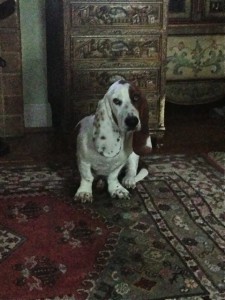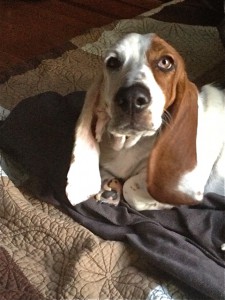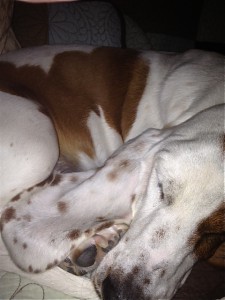Howllo Fellow Basset Hound and Fred Lovers…I found this article via the basset hound wires this morning and thought I would share…
Who does not love Fred? hehehe
By Alice Azania Jarvis
PUBLISHED: 17:56 EST, 9 July 2013 | UPDATED: 06:01 EST, 10 July 2013 
He is a canine icon, a pet pin-up, and a hound whose wry observations on human behaviour have endeared him to millions.
And this week, Fred Basset — ‘The Hound That’s Almost Human’ — celebrates his 50th birthday.
Since he first ambled onto the pages of the Daily Mail on July 9, 1963, Fred has made more than 18,000 appearances, capturing our hearts and winning fans across the world.
Five decades after his debut, he still features daily, his rabbit-chasing and bone-burying every bit as entertaining as ever.

The hound that stole our hearts: Much-loved comic strip star Fred Basset is fifty today
Not, it should be said, that you would have bet on his success at the start. His unusual looks — a skinny, stretched-out body and long, straight ears, not unlike a sausage dog — prompted readers to write in enquiring what exactly the strange dog was meant to be.
Not owning a dog himself, Fred’s creator, the late Scottish cartoonist Alex Graham, was a little hazy on just what a Basset Hound should look like. Graham had been asked to create a cartoon strip about a ‘thinking dog’ by the Mail’s then art editor, Julian Phipps.
Graham had trained at the Glasgow School of Art and was a regular contributor to Punch. Living in Ticehurst, East Sussex, in a neat brick house not unlike the suburban home belonging to Fred’s human owners, he chose to make his star a Basset Hound because they were, as he put it, ‘a unique type of dog’ with ‘rather expressive faces’.

After those early readers’ letters, the Mail gave Graham a (female) basset puppy, Freda, to help him capture the breed’s likeness.
The pair became inseparable. While Graham drew in his studio, Freda would sit watching. In the afternoons, when he went for his daily round of golf, she would follow him from tee to tee. In the evening, as he sat in his armchair with a whisky, she would curl up at his feet.
When Freda died a decade later, Graham was so heartbroken that he went out and bought another Basset, Freda 2.
In those early days, Graham practised drawing her so often that it wasn’t long before he could draw Fred in four seconds flat — and he would do so many thousands of time over.
His strips, set in a suburban household in an unidentified part of England, have always reflected a very British way of life — the kind of gentle, orderly existence which is becoming ever rarer in the modern world.
Fred’s owners are a golf-loving, pub-frequenting City worker and his house-proud wife. The local butcher features prominently — usually chasing a hungry Fred down the road. So, too, do local children Amanda and the Tucker Twins.
Then there are Fred’s partners-in-crime: Jock the Scottie; Yorky the terrier; Fifi the poodle (said to be based on Tosh, the rescue dog who joined the Graham household shortly after Freda); and Taffy, a Welsh terrier).
Asked whether the couple were modelled on him and his wife Winnifred, Graham always insisted that, if anything, it was Fred with whom he had the most in common.
Nevertheless, there was plenty about Graham’s life which did offer inspiration. His love of golf — shared with Fred’s master — is a mainstay of the strips. He would reverse the names of his friends when naming supporting characters, and his local pub, The Bull, appeared regularly.

Enduring: Fred Basset’s first appearance in 1963. In Germany he is known as Wurzel, in Italy he is Lilo and in Norway he answers to Laban
As the humans hurry about their daily business, happily unaware of their pet’s rich inner life, it is left to Fred to provide the commentary through his wry reflections.
As Graham himself put it: ‘He thinks they’re stupid, of course, but he’s very loyal and affectionate.’ It was a quality which endeared him to millions.
The paper was inundated with letters from readers who couldn’t get enough of Fred’s canine wit — and thought he should be rewarded with high office.
He should become a member of the Cabinet, said some. He should be given a knighthood. Some argued that Baron Basset might not be excessive.
The Basset Hound, meanwhile, gained new popularity. The Kennel Club reported a six-fold increase in Basset registrations within the first few years of Fred’s birth.

Every dog has its day: Fred is greeted by some of the rich cast of characters the strip has produced over the last five decades
As for Fred merchandise, you couldn’t escape it. Fans collected everything from life-sized furry Freds (ordered through the pages of the Mail) to T-shirts, mugs and towels.
As Fred’s fame grew, so did his international standing. His musings have appeared in some 200 newspapers around the world. In Germany he is known as Wurzel, in Italy he is Lilo and in Norway he is Laban.
And in the U.S., he captured the attention of the great humorist P. G. Wodehouse. When, in 1968, the strip was dropped from his daily, the Long Island Press, he successfully campaigned to have Fred reinstated.
Wodehouse wasn’t Fred’s only high-profile admirer. Hank Ketchum, who created Denis the Menace, and Charles M. Schulz, the illustrator behind the equally famous cartoon dog Snoopy, were both self-confessed fans.
And Anne Armstrong, U.S. ambassador to Britain during Gerald Ford’s Presidency, was so enamoured that when her term ended in 1977, she wrote to the Mail requesting a Fred print to take home as a souvenir.

Alex Graham and his wife Winnifred with Freda. When Freda died, Graham was so heartbroken that he went out and bought another Basset, Freda 2
It was only a matter of time before Fred was given his own TV show.
Lionel Jeffries, who had played the father of Caractacus Potts (Dick Van Dyke) in Chitty Chitty Bang Bang, voiced Fred’s thoughts in the 1976 series, which was broadcast daily in the five-minute slot before the Six O’Clock BBC1 News.
And then, of course, there were the books. The Fred Basset annual has been a Christmas stocking staple for generations. There was a Fred Basset For Golf Lovers, and now Fred Basset: Celebrating 50 Years.
When Alex Graham died aged 74 in December 1991, a month after being diagnosed with cancer, his millions of fans around the world faced the terrible prospect of losing their cartoon hero.
The artist had left a stockpile of 18 months’ worth of cartoons, but after that Fred’s future looked uncertain.
Until, that is, Graham’s daughter Arran stepped into the breach. Aged 14 when the strip started, Fred has, she says, always been part of her life.
‘I think the reason people love it is because they think Fred is their dog,’ she says. ‘Because Fred’s master and mistress have no name, everyone can relate to it.’
Now Arran comes up with the words for the strip, while Michael Martin, a British artist based in France, provides the drawings.

Muse: Graham shows Freda a sketch of Fred Basset
The ideas, she says, come to her as she goes about her day-to-day life. ‘I have notebooks everywhere — in my handbag, the car, in front of the television. A lot of ideas come from our cocker spaniel, Jemma.’
Little of the modern age has penetrated the comforting, unchanging world of Fred and his owners. Fred has aged not a jot, and his estimation of his owners’ intellectual prowess is as low as it ever was.
So here’s to another 50 glorious years of Fred, in all his sofa-hogging, rabbit-chasing, butcher-baiting glory.
* To order a copy of the limited edition anniversary special, Fred Basset: 50 Years, call the Mail Book Shop on 0844 472 4157 or visit mailbookshop.co.uk
End of article…
More loving famous hounds later…Cat, Daisy Lynn (Chaps and Emma very famous ATB)
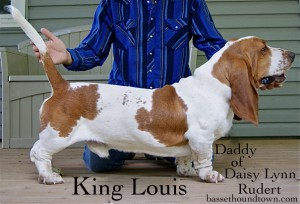
 Comments(3)
Comments(3)



